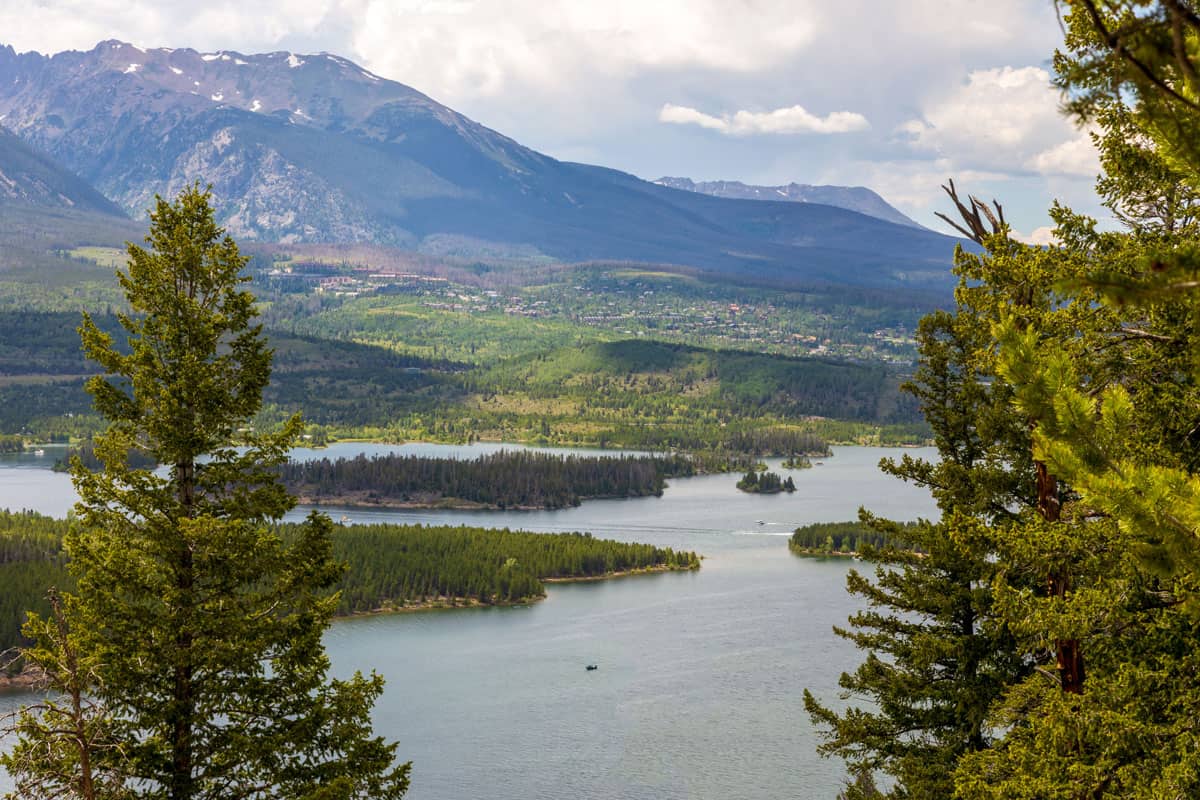The state of Colorado is famous for its picturesque landscapes that offer tons of recreational activities such as biking, hiking, skiing, horse-riding, canoeing, and others. Colorado is also a home to rich wildlife and diverse complex ecosystems as it boasts numerous types of nature-filled destinations like mountains, hot springs, dunes, and more.
If you are looking for an unwinding vacation that doesn’t have to take you to the beach, you can refresh in one of Colorado’s lakes! The state harbors more than 4,000 lakes and reservoirs on its state lines, and all of them offer different kinds of functions. From boating, fishing, and cooling off, you’ll never run out of beautiful and massive lakes to choose from in Colorado. You can surely do more in the state’s largest lakes and reservoirs. This article will explore the 15 largest lakes in Colorado.
Discover the 15 Largest Lakes in Colorado

15. Morrow Point Reservoir

Measuring 1.28 square miles, Morrow Point Reservoir’s most amazing landmark is the Crecanti Needle.
©iStock.com/kevinruss
Morrow Point Reservoir, a lake inside the Curecanti National Recreation Area, is frequently overshadowed by the considerably larger Blue Mesa Reservoir. It measures 1.28 sq mi or 3.306 sq km. The lake is a narrow reservoir that begins not far to the west of Blue Mesa. It’s an ideal mountain lake for fishing and hiking. Morrow Point’s most amazing landmark is the Curecanti Needle, which rises from the southern shore.
14. Lake Nighthorse
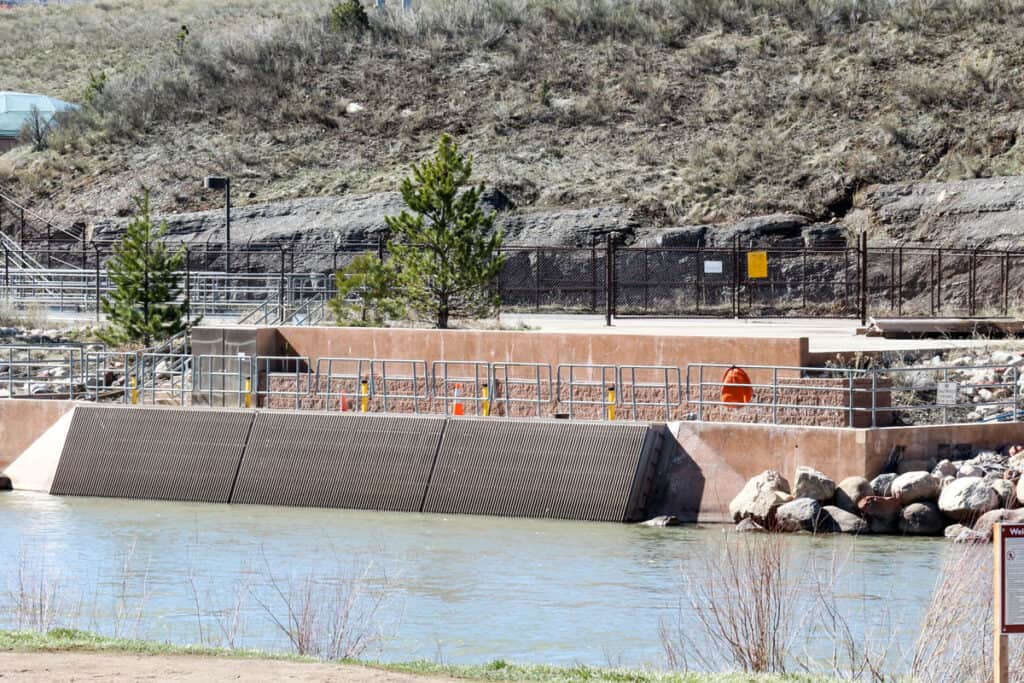
Lake Nighthorse offers plenty of fishing opportunities.
©iStock.com/KaraGrubis
Covering a total surface area of 2.32 sq mi or 6.03 sq km, Lake Nighthorse provides enough water storage for water rights claim-holders in the Animas River. It is a reservoir built by the Ridges Basin Dam, which measures 270 feet high. The lake offers plenty of fishing opportunities as Kokanee salmon, rainbow trout, and brown trout have been added to the reservoir.
13. Vallecito Reservoir
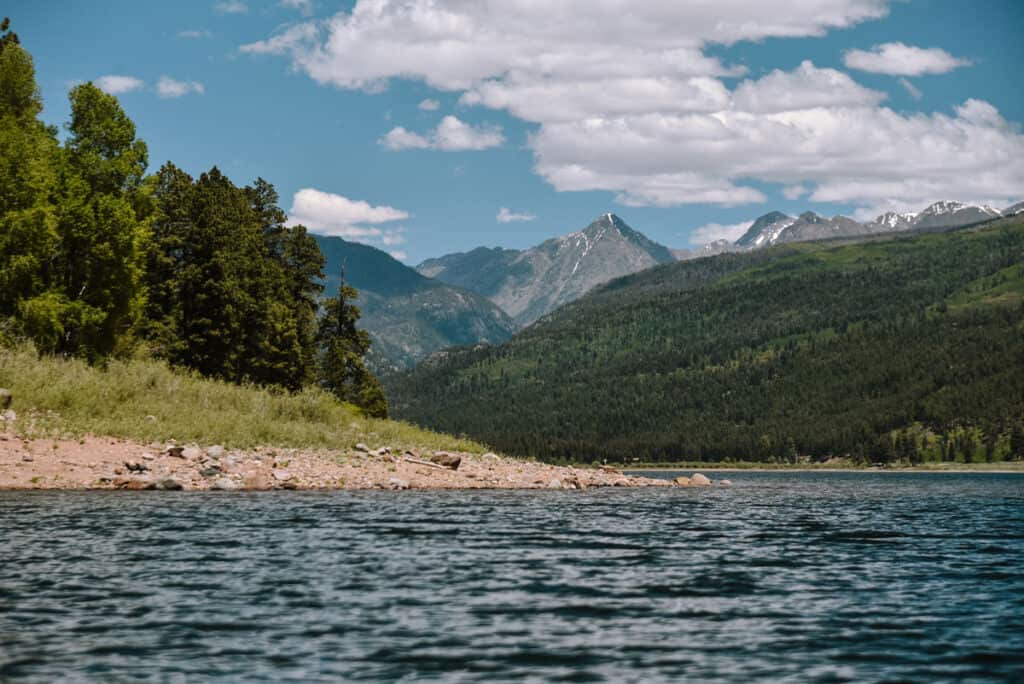
Vallecito Lake is one of the largest lakes in Colorado with a surface area of 4.25 square miles.
©iStock.com/Alisha Bube
The Vallecito Reservoir or Vallecito Lake has a surface area of 4.25 sq mi or 2,720 acres when filled to its maximum capacity. It can hold the most water volume of 129,700 acre-feet. Located in La Plata County’s Bayfield, Vallecito Lake is a fantastic spot for all kinds of outdoor activities. There are various ways to enjoy the view of the lake’s waters, from trekking down to driving around the national park.
12. Turquoise Lake

Fishing, kayaking, and canoeing are popular activities on Turquoise Lake.
Turquoise Lake, barely five miles west of Leadville’s Historic District, is a sight to behold. It has a total surface area of 2.78 sq mi or 1,780 acres and holds 129,440 acre-feet of water or 159,660,000 cubic meters. Its lovely waters are a wonderful area to go fishing. Kayaking and canoeing are popular activities for visitors in the lake.
11. Green Mountain Reservoir
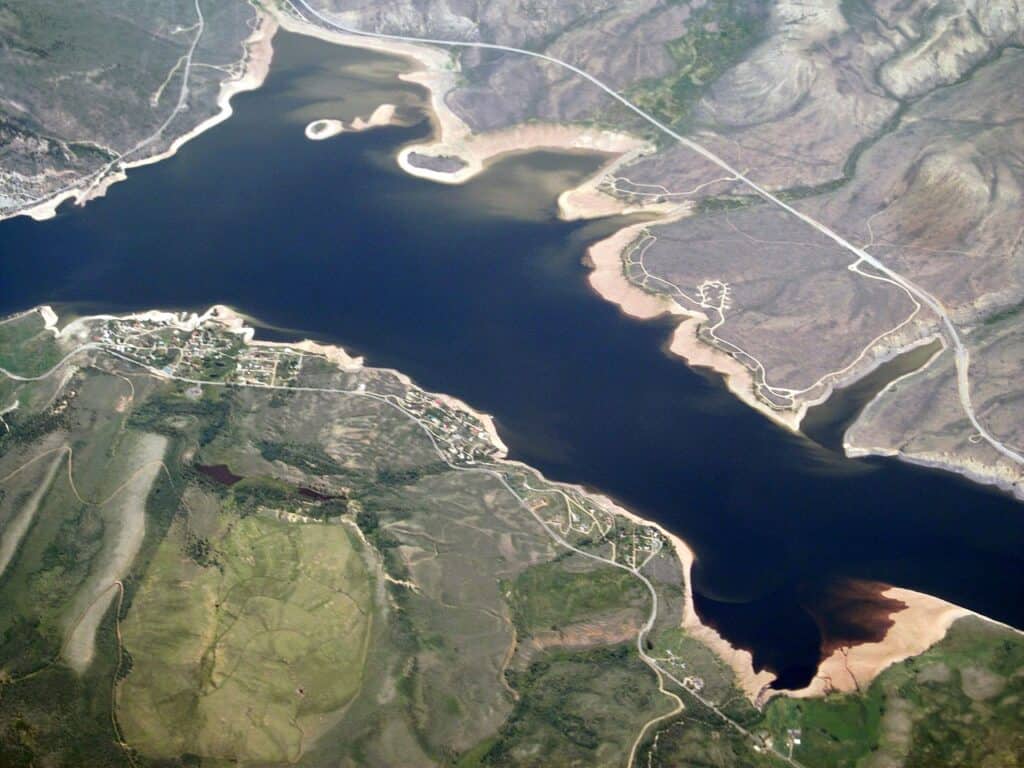
At maximum capacity, the Green Mountain reservoir is 7,950 feet high.
Green Mountain Reservoir is a huge mass of water located in Summit County, Colorado. It is supplied by the Blue River, which drains into the Colorado River in Grand County to the north near Kremmling. The reservoir can hold 153,000 acre-feet of water or 189,000,000 cubic meters. The lake is 7,950 feet high at maximum capacity, and the dam is 309 feet tall. Brown trout, rainbow trout, and salmon are replete in the lake.
10. Horsetooth Reservoir

Water skiing and boating are common sports in the area of Horsetooth Reservoir.
©iStock.com/marekuliasz
Horsetooth Reservoir is a vast reservoir in southern Larimer County, Colorado, west of Fort Collins. The reservoir has a total surface area of 2.96 sq mi or 7.68 sq km and is approximately 6.5 miles long and one-half mile wide, running north to south. It’s a popular spot for escaping the summer heat. Water skiing and boating are common sports in this area. Taking its name from the surrounding Horsetooth Mountain, the reservoir provides municipal water to Fort Collins, Greeley, and other municipalities in the area and irrigation for the lower South Platte River basin.
9. Twin Lakes Reservoir

Mount Hope and Rinker Peak can be seen from the northern shore of Twin Lakes.
©Serj Malomuzh/Shutterstock.com
The Twin Lakes are located at the base of Mt. Elbert, Colorado’s highest summit. Hikers, anglers, and sightseers enjoy the naturally formed glacial lakes. The Twin Lakes Reservoirs cover a total area of 4.21 sq mi or 2,695 acres, and both offer good brown, rainbow, and cutthroat trout fish and trophy lake trout. The lake also provides an excellent spot for fishing and camping along the lake or neighboring hillsides.
8. Sanchez Reservoir

As a designated wildlife area, the lake’s visitors must be aged at least 18 with a Colorado hunting/fishing license.
Covering 4.91 sq mi or 12.73 sq km, Sanchez Reservoir is a lesser-known reservoir in Costilla County, located about 10 miles south of San Luis, Colorado, the state’s oldest inhabited town. Because it is a designated state wildlife area, only adults 18 years old and older with a valid Colorado hunting or fishing license are permitted to use its services.
7. Dillon Reservoir
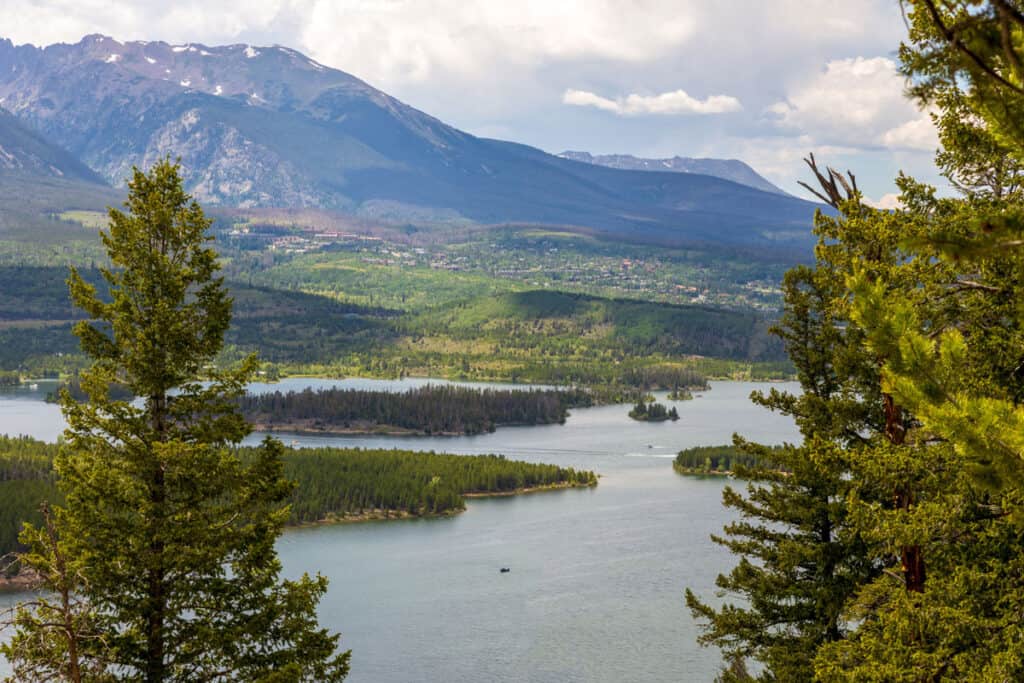
The Dillon Reservoir has a total surface area of 5.05 square miles, making it a major freshwater lake in Summit County.
©iStock.com/Faina Gurevich
Often known as Lake Dillon, the Dillon Reservoir is a major freshwater reservoir in Summit County, Colorado, in the United States. It has a total surface area of 5.05 square miles or 13.08 square kilometers, and Denver Water controls its waters. Dillon Reservoir may get crowded, but there are plenty of surface acres to explore. The fishing is excellent, and the reservoir is dotted with lakeside campgrounds.
6. Lake Pueblo

Visitors to Lake Pueblo can enjoy prime fishing, sailing, wakeboarding, and wake surfing.
©iStock.com/Faina Gurevich
Lake Pueblo encompasses 7.18 sq mi or 4,600 acres of water surface area and over 40 sq km of land. The lake also has 60 miles or 97 kilometers of shoreline that offer full-service marinas. Lake Pueblo is famed for its fishing. In the pleasant year-round atmosphere, guests can enjoy a range of outdoor activities around the lake, such as sailing, wakeboarding, wake surfing, prime fishing, or motor-boating. The Pueblo Dam impounded Lake Pueblo, also known as Pueblo Reservoir, whose primary purpose is to provide water for industrial and agricultural purposes. With a maximum depth of 135 feet or 41 meters, the lake is also used for recreation and wildlife.
5. McPhee Reservoir

The reservoir is named after the former town of McPhee, which is submerged beneath its waters.
©iStock.com/Joshua Bauer
The magnificent McPhee Reservoir is on the Dolores River and contains 381,051 acre-ft of water volume. This is one of Colorado’s largest lakes, with a surface area of approximately 4,470 acres. The dam has a length of 1,300 feet and 30 feet. It reaches a height of 270 feet above the stream bed at its top. The construction of the Great Cut Dike and McPhee Dam on a saddle resulted in the formation of this reservoir. The reservoir is named after McPhee, Colorado, founded by the New Mexico Lumber Company that is now submerged beneath the reservoir.
4. Lake Granby

Hosting 260 campsites, Lake Granby makes a perfect place for a holiday vacation.
©iStock.com/Lunnderboy
Lake Granby is known for its abundant supply of lake trout and salmon. With 11.33 sq mi or 29.36 sq km surface area, the lake hosts 260 campsites along its shorelines filled with tourists and visitors as they experience the lake’s numerous outdoor activities. The lake, which was created in 1950 due to the construction of Granby Dam, is only five miles from Granby and has a 40-mile shoreline. As it has numerous campsites dotted along its shores, the lake also makes a perfect place for a holiday vacation.
3. John Martin Reservoir
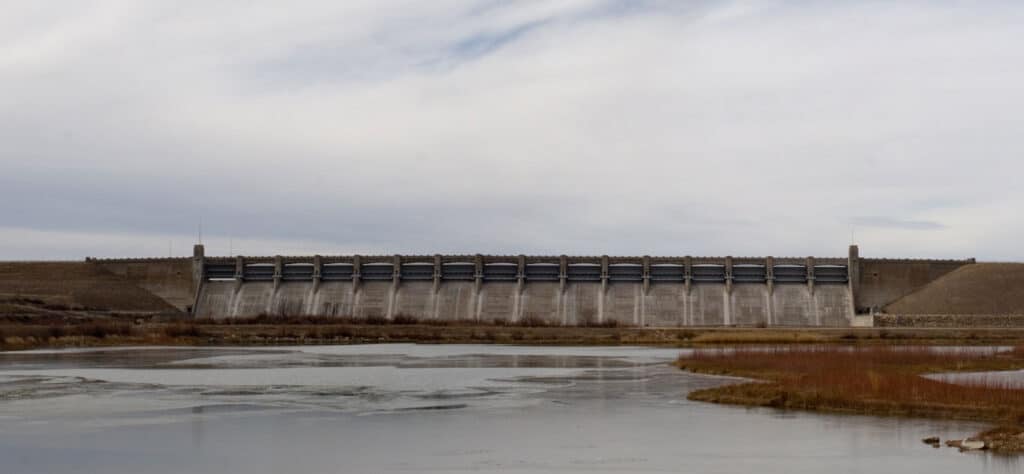
The John Martin Reservoir gets its water from the Arkansas River.
©Tim Pleasant/Shutterstock.com
Located in Southeastern Colorado, the John Martin Reservoir has a total surface area of 26.5 sq mi or 68.8 sq km, surpassing Blue Mesa by size. However, its water volume can only reach 340,771 acre-feet at full capacity. Hence, it is considered less massive than the Blue Mesa Reservoir. Colorado has a lot to be proud of regarding this reservoir. This captivating lake, also known as a “Sapphire on the Plains,” has been attracting visitors worldwide to see the nearby historic landmarks, exquisite fauna, and recreational opportunities. It sits east of Pueblo in Hasty, and it gets its water from the Arkansas River.
2. Navajo Reservoir

While a section of the Navajo Reservoir is in Colorado, most of the lake is situated in New Mexico.
©Timthefinn at English Wikipedia / This work has been released into the public domain by its author, Timthefinn at English Wikipedia. This applies worldwide. – Original / License
With a total surface area of 24.37 sq mi or 63.13 sq km, the Navajo Reservoir beats the Blue Mesa Reservoir by size. However, the Navajo Reservoir doesn’t sit within Colorado. It just touches a part of the state. The Navajo Reservoir is mainly located in San Juan County in New Mexico. Still, some portions of the reservoir connect to Archuleta County in Colorado, making the lake one of the largest that extends to Colorado. The Navajo Reservoir offers a variety of recreational opportunities like camping and lodging. Professional fishing guides are also available to take you to some fantastic fishing locations. Afterward, you can sit around a lakeside bonfire under the stars.
1. Blue Mesa Reservoir
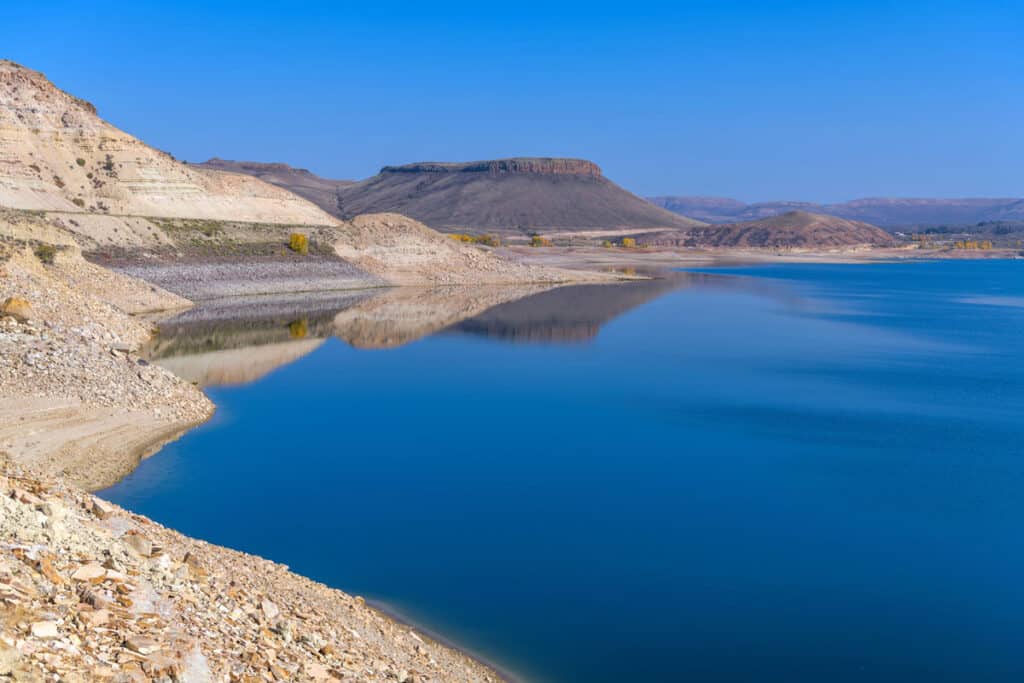
The Blue Mesa Lake is the largest lake in Colorado.
©iStock.com/SeanXu
Blue Mesa is an artificial lake located in western Colorado, adjacent to the town of Gunnison, and stretches for around 20 miles. It encompasses 14.34 sq mi or 37.15 sq km and is the largest known lake by volume within the confines of the state. Many other reservoirs may be bigger than Blue Mesa’s surface area but it is the largest solo pride of the state. The beach stretches for an incredible 60 miles or 96 km. The Blue Mesa Reservoir offers superb water activities such as paddleboarding, kayaking, and boating. It holds a water capacity of 940,800 acre-feet and was constructed in 1966 to generate hydroelectric power. Blue Mesa Reservoir is Colorado’s greatest lake trout and Kokanee salmon fishery, managed by the Curecanti National Recreation Area.
Summary of 15 Largest Lakes in Colorado
Here’s a recap of the 15 biggest Colorado lakes that we took a look at.
| Number | Lake | Size |
|---|---|---|
| 1 | Blue Mesa Reservoir | 14.34 sq mi |
| 2 | Navajo Reservoir | 24.37 sq mi (also in New Mexico) |
| 3 | John Martin Reservoir | 26.5 sq mi (water volume reaches 340,771 acre-feet) |
| 4 | Lake Granby | 11.33 sq mi |
| 5 | McPhee Reservoir | 4,470 acres |
| 6 | Lake Pueblo | 7.18 sq mi |
| 7 | Dillon Reservoir | 5.05 sq mi |
| 8 | Sanchez Reservoir | 4.91 sq mi |
| 9 | Twin Lakes Reservoir | 4.21 sq mi |
| 10 | Horsetooth Reservoir | 2.96 sq mi |
| 11 | Green Mountain Reservoir | 2,130 acres |
| 12 | Turquoise Lake | 2.78 sq mi |
| 13 | Vallecito Reservoir | 4.25 sq mi |
| 14 | Lake Nighthorse | 2.32 sq mi |
| 15 | Morrow Point Reservoir | 1.28 sq mi |
Thank you for reading! Have some feedback for us? Contact the AZ Animals editorial team.

